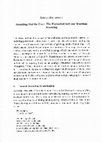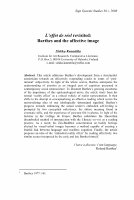Books by Sirkka Knuuttila
Fictionalising Trauma: The Aesthetics of Marguerite Duras's India Cycle
With Marguerite Duras being the most disputed French artist after World War II, symbolising traum... more With Marguerite Duras being the most disputed French artist after World War II, symbolising trauma represents the most problematic crux of contemporary trauma research. This books brings together these troublesome issues by way of integrating Duras's aesthetics and the challenge of working through major historical trauma. Starting from the concept of an embodied mind as developed in current social neuroscience, the study illuminates the stylistic devices of the famous India Cycle that arose from Duras's relentless struggle with the trauma of French colonialism. It reveals how converting trauma into fiction can become a powerful emotional strategy for surviving traumatic events, which may provoke necessary changes in our cultural memory through collective sharing.

Fictionalising Trauma: The Aesthetics of Marguerite Duras's India Cycle
Fictionalising Trauma brings together the essential aspects of two troublesome issues: Marguerite... more Fictionalising Trauma brings together the essential aspects of two troublesome issues: Marguerite Duras’s cyclic aesthetics, and the challenge of working through major historical trauma. With Duras being the most disputed French artist after World War II, symbolising psychic trauma represents the undeniable problematic crux of contemporary trauma research. This stylistic analysis of the famous India Cycle offers an exploration of the novelistic and cinematic devices arising from Duras’s steadfast struggle with the trauma of French colonialism. Leaning on the concept of an embodied mind as developed in current social neuroscience, Fictionalising Trauma reveals how converting trauma into fiction can be a powerful emotional strategy for surviving traumatic events. The study also shows how Duras dissects European racism by progressively modifying and defamiliarising her key figures, thus suggesting a change in our cultural memory by collectively sharing trauma through art.
Papers by Sirkka Knuuttila
Degrés: Revue de synthèse á orientation sémiologique, publication internationale trimestrielle. Sémiotique existentielle No 116, hiver 2003, 2003
, Eero Tarasti dit que le sujet devient un ötre existentiel par le processus s6miotique : en cr6a... more , Eero Tarasti dit que le sujet devient un ötre existentiel par le processus s6miotique : en cr6ant la douleur psychique ne doit pas 6tre seulement un acte thdrapeutique Kathleen Woodward a ainsi notd qu'il nous manque un discours plus expressif sur le processus int6rieur de deuil. En citant des pensdes psychanalytiques de J.-B. Pontalis Woodward place le concept de douleur psychique entre les pöles contradictoires m€lancolie/deuil de la psychanalyse freudienne, qui n'est ni pathologique et incessante comme la m6lancolie, ni saine et de dur6e limit6e comme le processus de deuil. Elle prendra I'exemple barth6sien de "l'affection intentionnelle" du deuil par la photo de sa möre. (Woodward l990l9l, 94-lO2).
Es war ein wunderschönes Juliwetter in Kuhmo, einer berühmten Kammermusikstadt in der nordostfinn... more Es war ein wunderschönes Juliwetter in Kuhmo, einer berühmten Kammermusikstadt in der nordostfinnischen Provinz Kainuu, als ich zwischen den Konzerten von der Kirche zum Konzerthaus radelte. Wie gewöhnlich verfolgte ich genießend, wie sich die Räume zwischen den Ästen und Zweigen plastisch verwandelten. Ich atmete tief die duftende Luft ein, während mein Fahrrad im milden Sonnenschein vorwärts rollte. Plötzlich sah ich simultan die Wolken über den Baumkronen und hörte mich laut auf Deutsch sagen: "Zirren nein Zirben". In dem Augenblick bemerkte ich, wie die Formen der weißen Zirren über den dunklen Formen der Zirben die Zweige ikonisch wiederholten. Enorm glücklich dachte ich: Jetzt ist es hier!

"Hello, I Say, It's Me" - Contemporary Reconstructions of Self and Subjectivity, Eds. Jan D. Kucharzewski, Stefanie Schäfer, Lutz Schowalter, 2009
This essay outlines the concept of the embodied self as a tentative part in formulating postratio... more This essay outlines the concept of the embodied self as a tentative part in formulating postrational subjectivity. It serves the idea of empathic reading that can resist numbness under the pressure of growing media. Postulating a self which has an embodied core implies a capability of becoming aware and reflecting affectively on the non-verbal exchange of self and other. For this purpose, I investigate the neural basis of this hypothesis in terms of Antonio Damasio, and adapt it to Daniel N. Stern's idea of the present moment as the felt locus of implicit knowing. Moreover, to illuminate the working of the embodied self in reading, I use as an example Friederike Mayröcker's poem "Fotografie." Since the poem sensitively echoes implicit memory in traumatic loss, I explore its figures as multisensory signs which the poet transfers from her emotional memory into language. Especially the metonymies of the poem express the dual affect of sorrow and love when verbally bridging the temporal delay typical of traumatic memory.
Redefining Literary Semiotics, 2009

Sign Systems Studies vol 36.1, 2008
The article addresses Barthes’s development from a structuralist semiotician towards an affective... more The article addresses Barthes’s development from a structuralist semiotician towards an affectively responding reader in terms of ‘post-rational’ subjectivity. In light of his whole oeuvre, Barthes anticipates the understanding of emotion as an integral part of cognition presented in contemporary social neuroscience. To illustrate Barthes’s growing awareness of the importance of this epistemological move, the article starts from his textual ‘reality effect’ as a critical vehicle of realist representation. It then shifts to his attempt at conceptualising an affective reading which resists the universalising idea of one ideologically determined signified. Barthes’s progress towards embracing the actual reader’s embodied self-feeling is prompted by two conceptual milestones: the obtuse meaning found in cinematic stills, and the experience of punctum felt in photos. In light of his lectures in the Collège de France, Barthes substitutes the Husserlian disembodied method of introspection with the Chinese wu-wei as a reading practice. As a result, his Zen-Buddhist concentration on bodily feelings elicited by visual/verbal images becomes a method capable of creating a fruitful link between language and wordless cognition. Finally, the article proposes an idea of the ‘embodied reality effect’ by reading affectively two similar scenes interpreted by the early and late Barthes himself.










Uploads
Books by Sirkka Knuuttila
Papers by Sirkka Knuuttila